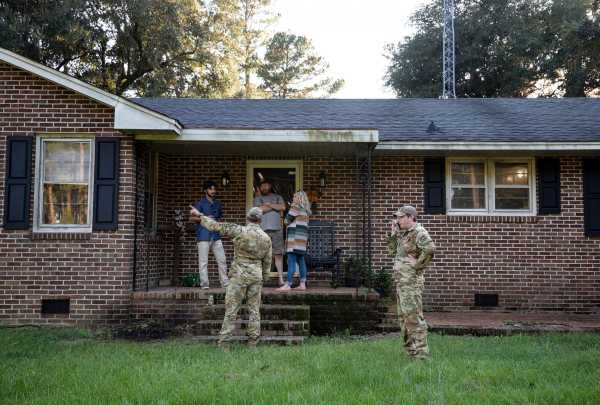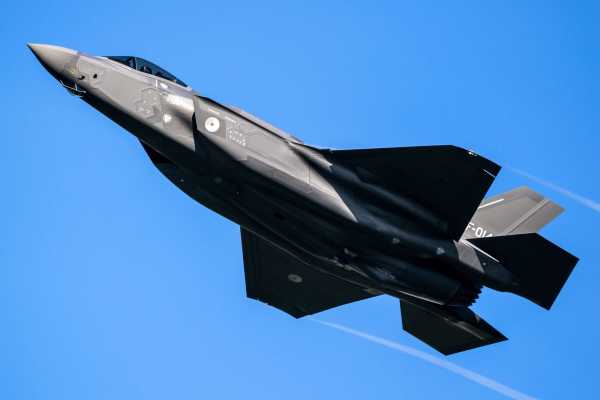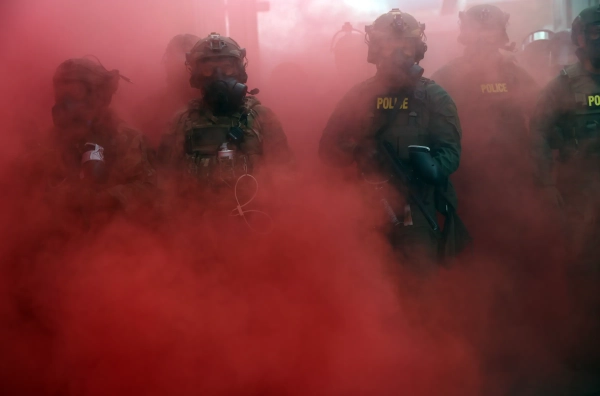The perplexing moments after a military pilot ejected from the F-35 fighter jet that crashed and went temporarily missing were captured in a dramatic 911 call.
The call details the strange encounter between the 47-year-old Marine Corps pilot, the South Carolina man whose backyard he parachuted into and an emergency dispatcher.
"I guess we got a pilot at our house, and he says he got ejected or he ejected from the plane. So, we just seeing if we could get an ambulance please," the homeowner says at the beginning of the call.
"I'm sorry, what happened?" the dispatcher replied.
MORE: New details in F-35 'mishap' as mystery remains about how jet was lost
Seconds later, the pilot himself takes over and begins to speak with the 911 operator.
"We had a military jet crash," he said. "I'm the pilot. We need to get it rescue rolling. I'm not sure where the airplane is. It would have crash landed somewhere. I ejected."

Airmen from Joint Base Charleston speak to a family living right next to the site of a crashed F-35 about the operation to recover the fighter jet and requests for the family in Williamsburg County, S.C., on Sept. 18, 2023.Henry Taylor/The Post And Courier via AP
The pilot, whose name has not been released, went on to ask if there were any reports of a crashed plane.
The jet crashed on Sunday after what the Marine Corps said was a malfunction that prompted the pilot to eject near the Charleston airport. But the $100 million fighter jet wasn't found until more than 24 hours later approximately 60 miles north of Joint Base Charleston, missing some heavily populated areas.
The temporarily missing jet prompted questions about what exactly went wrong, and why it took so long to locate.
In a statement, a Marine Corps official said it was a combination of things, including the stealth jet's design that keeps it flying after ejection as well as bad weather. But questions remain about the search timeline and what exactly went wrong in the jet that forced the pilot to eject.
There is software that will allow the jet to maintain "normal flight equilibrium" or a "1G state" even if the pilot takes their hands off the control, the official's statement explained.
"If it was in an established climb or descent, the jet will maintain a 1G state in that climb or descent until commanded to do something else," the official said. "This is designed to save our pilots if they are incapacitated or lose situational awareness. It is designed to save their life, and the good news is it appeared to work as advertised."
Military aircraft are usually tracked by radar and transponder codes, the official said, but they are designed to erase all secure communications once a pilot ejects. The jet would then broadcast an unclassified, "Mode 3C": Identification Friend / Foe (IFF) signal but air traffic control's ability to pick up the signal depends on the weather, the terrain and where the radar was located.
"When coupled with the F-35's stealth capabilities, tracking the jet had to be done through non-traditional means," the statement said. Thunderstorms carrying heavy rain and periods of reduced visibility — with cloud ceilings below 1,000 feet further — also hampered search efforts, the official's statement said.
Plus, the statement said the Emergency Locator Transmitter — a system designed to help locate a pilot after ejection — is physically located in the ejection seat and can't track the aircraft once it departs the aircraft.

Lockheed Martin F-35 Lightning II on Oct 7, 2021.STOCK PHOTO/Getty Images
The pilot reported falling about 2,000 feet after an "aircraft failure."
"I feel OK my back just hurts," he said on the 911 call. The homeowner is also heard telling the dispatcher the pilot "looks fine" and had a "couple scratches."
MORE: As Marines continue to search for F-35 after 'mishap,' officials order 2-day stand-down for all jets
According to a defense official familiar with the investigation, the pilot is an experienced Marine Corps aviator with decades of experience.
As to the 28-hour search for the jet debris, the Marine Corps official said there were a number of factors for the delay — including thunderstorms in the area that reduced visibility.
"There are a multitude of reasons why the aircraft was found a day later," the official said. "The fact that this is the world's premiere stealth fighter, coupled with software and survival systems designed to save pilots pre-ejection and ensure we can locate the pilot post ejection, and bad weather all combined to make finding the aircraft difficult."
Sourse: abcnews.go.com






